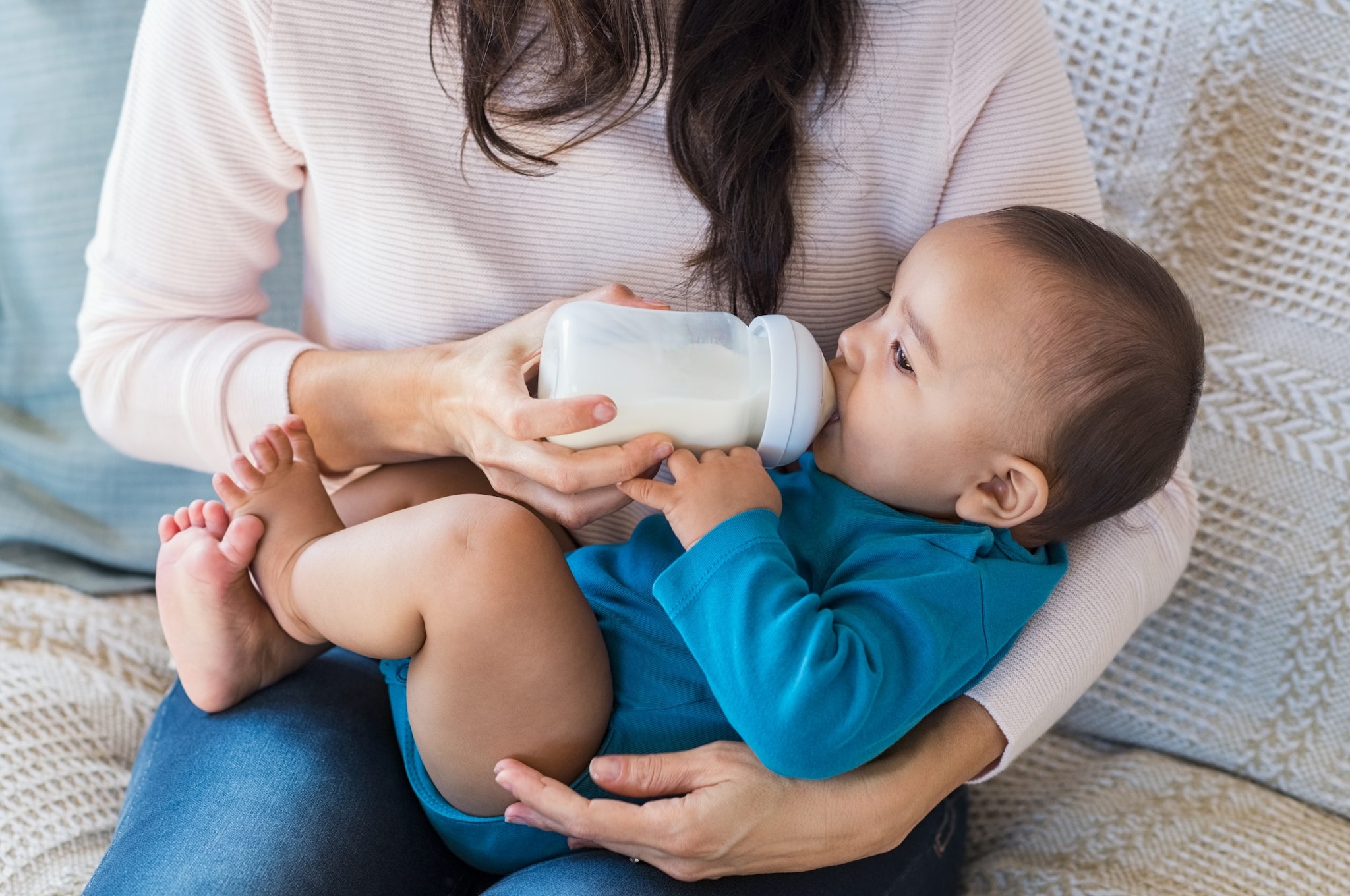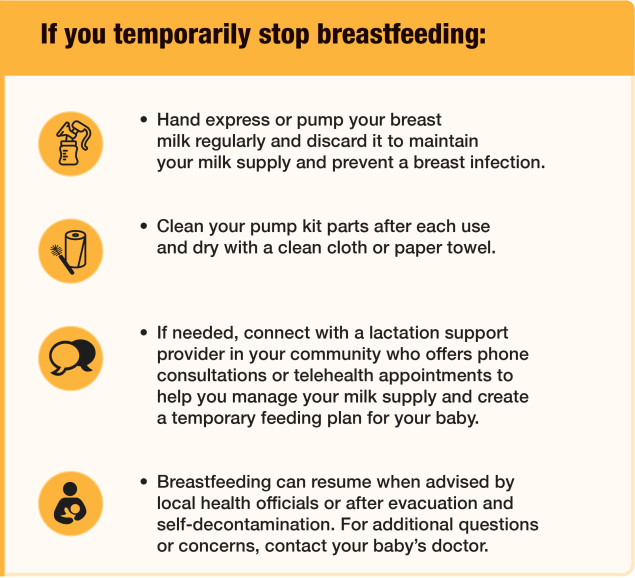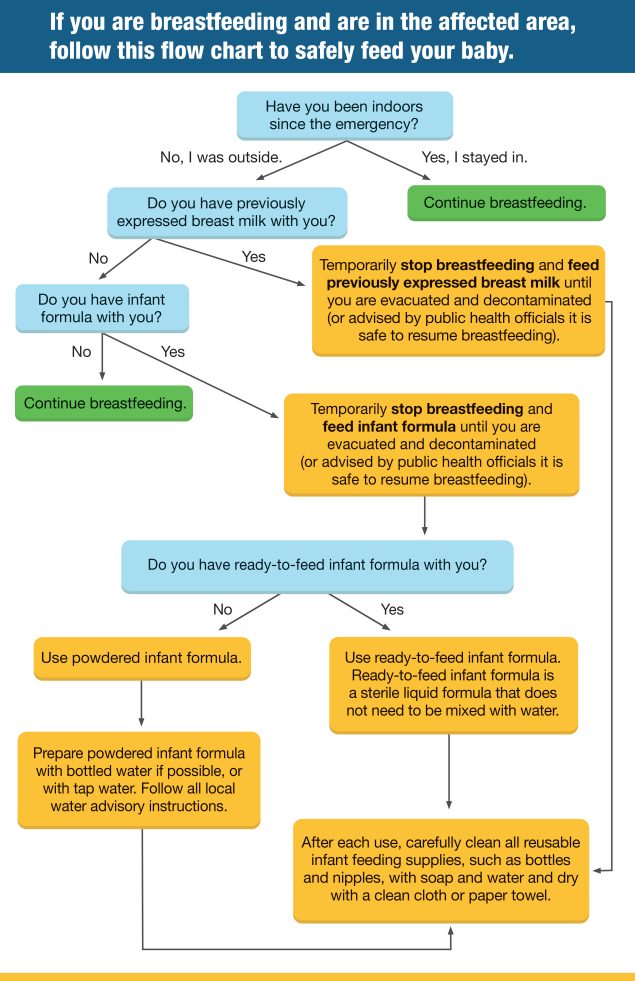What to know
If you were outside during a radiation emergency, consider different ways to feed your baby other than breastfeeding. You could have internal contamination, which you can pass to your child through breastmilk. You can also spread radiation from your skin and clothes.

How to feed your baby during a radiation emergency
Mothers who are in the affected area might be exposed to radiation and may also be internally contaminated. This is possible if they eat, drink, or breathe in radioactive material.
Radioactive material can be passed to babies:
- Through breast milk of mothers with internal contamination
- Through contaminated water mixed with infant formula
- While being held and fed if their caregiver has radioactive material on their skin or clothing (external contamination)
Immediate steps to take
Listen to local officials for the most up-to-date information about staying safe after a radiation emergency. Local officials will define and provide updates on
- The location of the affected area
- The safety of the water for drinking and other uses
- Evacuation instructions
If you are outside in the affected area, take the following steps to reduce your risk of exposure and internal contamination:
- Get inside, stay inside, stay tuned.
- Wash yourself off (self-decontaminate). Gently use soap and warm water to remove radioactive material from your body as soon as possible and lower your risk of harm. Put on clean clothes.
- Then, decontaminate your baby or child. Make sure to gently wash your child's hands and face (especially around eyes, nose, and mouth) with soap and water or with a clean wet cloth or paper towel.
- Put clothes and towels in a plastic bag or other sealable container. Store the bag as far away from other people and pets as possible (e.g. closet, attic, basement), to prevent exposure to radiation until local health officials tell you how to dispose of it safely.
Breastfeeding
If you were inside
If you are in the affected area and were indoors with the doors and windows closed, it is safe to continue breastfeeding.
If you were outside
If you were outside in the affected area during the incident, you may be internally contaminated.
Consider temporarily stopping breastfeeding and feed your baby with breast milk that was pumped and stored before the emergency or with infant formula. These options will reduce the risk of transmitting radioactive material to your baby through breast milk.
If you do NOT have previously expressed breast milk or infant formula, continue breastfeeding.

Pumped and stored breast milk
Feeding your baby breast milk that was pumped and stored before the emergency:
- Use previously expressed breast milk to feed your child because it will not be contaminated. Closed containers of milk that were stored inside the refrigerator or freezer are safe to use.
- Wash your hands with soap and water before feeding.
- After each use, carefully clean all infant feeding supplies such as bottles and nipples with soap and water and dry with a clean cloth or paper towel.
Formula feeding
Use ready-to-feed infant formula, if available at your current location.
Ready-to-feed formula is considered the following:
- A sterile liquid formula that does not need to be mixed with water
- The safest option for formula-fed infants during an emergency
If you do not have ready-to-feed infant formula, use powdered infant formula. Do NOT leave your house or other indoor sheltering location to go get infant formula. It is safer to stay inside and continue breastfeeding.
- Prepare powdered infant formula with bottled water if possible.
- Tap water may be used if local officials say it is safe. You cannot boil or disinfect the radiation out of water.
- If your baby is younger than 2 months old, was born prematurely, or has a weakened immune system, you may want to take extra precautions to protect against Cronobacter.
- Wash your hands with soap and water before feeding.
- After each use, carefully clean all infant feeding supplies, such as bottles and nipples, with soap and water and dry with a clean cloth or paper towel.
If you do not have breast milk or formula milk
Continue breastfeeding. It is important to stay inside and make sure your baby is hydrated and fed. Wash your hands, nipples, and breasts thoroughly with soap and warm water before breastfeeding or expressing milk.
If you are advised to visit a Community Reception Center (CRC) when evacuating, tell CRC staff how you are feeding your baby so that they can help you or advise you on how to feed your baby safely.
Breastfeeding can resume when advised by local health officials or after evacuation and self-decontamination. For additional questions or concerns, contact your baby's doctor.
Visual flowchart for breastfeeding families

